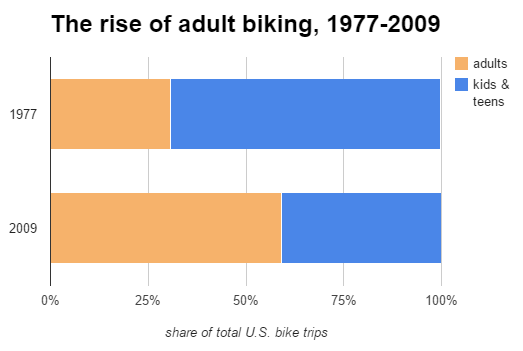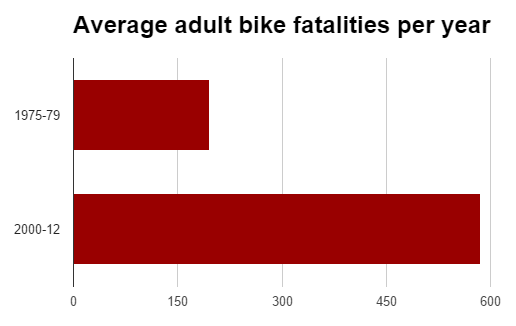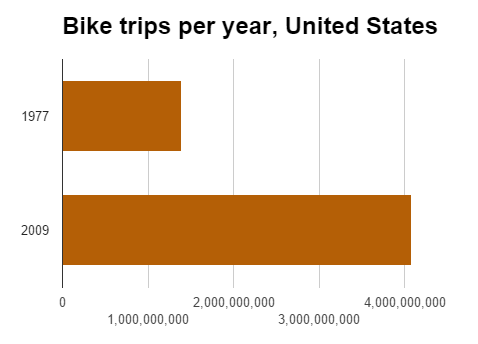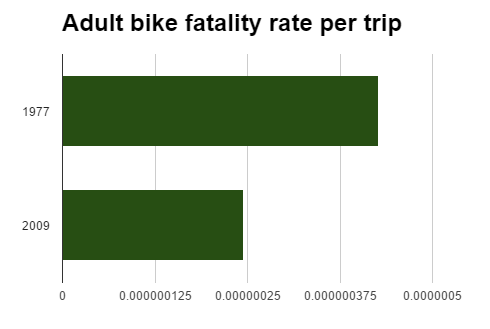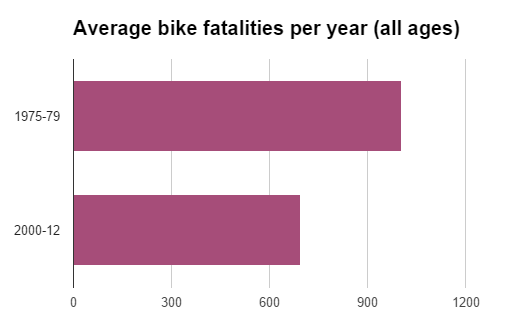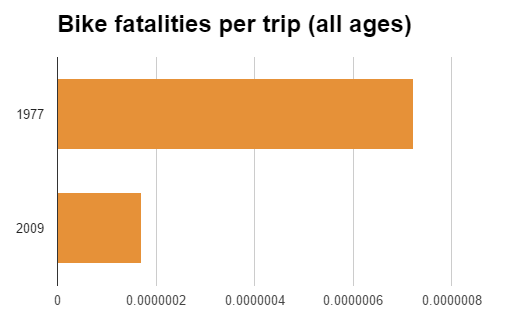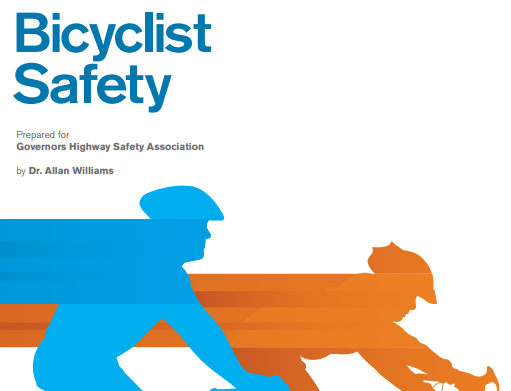
(Click for report.)
A report released by the Governors Highway Safety Association Monday is a perfect example of what can go wrong when safety experts get stuck behind their own windshields.
The GHSA, an umbrella organization for state departments of transportation whose claims to fame include popularizing the phrase “aggressive pedestrians,” is surely staffed by smart people who are working hard to reduce injuries and deaths. But the problems in this report start right at the top.
Let’s take them one by one.
The language framing the report is pointlessly divisive
Spotlight on Highway Safety: Bicyclist Safety
As Jonathan has said for years, the word “bicyclist” is silly because it’s rooted in the idea that people are monomodal — that a “bicyclist” is a fundamentally different sort of person than a “motorist.” We should all just use the word “bicycling” instead. Anybody can bicycle. (And most Americans do.)
As the headline of the GHSA press release about this report (and therefore the framing of umpteen media stories being published about it) shows, this isn’t a trivial concern:
Bicyclist Fatalities a Growing Problem for Key Groups
Adult Males and Urban Environments Now Represent Bulk of Deaths
As if fatalities among these “key groups” aren’t a problem for the rest of us, too?
Then there’s the subtitle, which gives a hint of the single biggest problem in this report…
The report makes no effort to calculate fatality rates as a share of ridership
Here’s one of the five terrifying infographics helpfully released by the GHSA, in accordance with the modern media best practice of making it easy for reporters to do their job entirely by copying and pasting.
I’m not sure why report author Dr. Allan Williams, the former chief scientist for the Insurance Institute for Highway Safety, decided to assess the risk of biking by tallying the number of times somebody died rather than considering the probability that somebody would die.
In any case, to help him out, I spent an hour looking up some figures from the 1977 and 2009 National Household Travel Surveys that might help put this report in perspective. For example, it’s possible that the increasing share of bike deaths among adults (shown in the chart above) might have something to do with this:
With a calculator we can also use Williams’s numbers to estimate the absolute number of adult bike fatalities per year:
And, oh yeah, it might be helpful to consider this:
Hey, you know what? We ought to be able to put this all together and figure out … well, what do you know.
For those of you keeping count, that’s a 43 percent decline in the risk of getting on bike.
That said, it’d be great to further reduce this risk. Let’s look at some other passages from the report.
The list of states where there are lots of bike fatalities is just a list of states where there are lots of people
The greatest numbers of bicyclist deaths occurred in high population states with many urban centers: California (338), Florida (329), Texas (143), New York (138), Illinois (80), and Michigan (72). These six states accounted for more than half (54 percent) of all bicyclist fatalities during this time period.
Here are the five most populous U.S. states: California, Texas, New York, Florida, Illinois. Michigan is ninth. I believe the webcomic XKCD has offered the definitive analysis of an “analysis” such as this.
Between 2010 and 2012, deaths increased in 22 states, decreased in 23 and D.C. and stayed the same in five. That is, less than half the states had increases in deaths over this period when deaths were increasing nationally. This is due to a few states having large increases, especially in Florida (+37) and California (+23). There were also double-digit increases in Texas (+14) and Louisiana (+12). The largest decrease was in Michigan (-10).
Okay! This is a slightly more useful observation. Here’s another way to phrase it: though bike deaths continue to become less common in most states, in the last few years they’ve become more geographically concentrated, especially in Florida, California, Texas and Louisiana.
The report dismisses the rapidly spreading installation of protected bike lanes
Roads were built to accommodate motor vehicles with little concern for pedestrians and bicyclists. Integrating motor vehicles and bicycles in already-built environments presents challenges. The most protective way to accomplish this is through total physical separation of bicycles and motor vehicles. Research confirms that “cycle paths,” which do this, provide the best safety (Teschke, 2012), but they are rarely feasible.
Williams makes a policy judgment here in the face of the fact that cycle tracks (I think that’s the phrase he was looking for) are rapidly being installed across the country as we speak. He goes on to mention bike lanes, bike boulevards, and bike-only signals as more “feasible” ways to increase bike safety.
He does not discuss the feasibility of continuing to expand auto capacity throughout the nation’s suburbs in an unending hope that the next travel lane will be the one that never fills up.
Advertisement
The report names drunk biking and biking without a helmet as major safety problems without offering evidence
Despite the association of biking with healthy lifestyles and environmental benefits, a surprisingly large number of fatally injured bicyclists have blood alcohol concentrations of 0.08% or higher. This was the case for 28 percent of those aged 16 and older in 2012, just a few percentage points lower than for passenger vehicle drivers with high BACs (33 percent). The percentage of bicyclists with high BACs has remained relatively constant from 1982 to 2012, ranging from 23 percent to 33 percent. Of note is the fact that between 1982 and 1992, the percentage of high BACs among bicyclists changed little, but dropped sharply for passenger vehicle drivers.
It’s not clear why it’s “surprising” that people involved in crashes while biking are slightly less likely to be drunk than people who are involved in crashes while driving. Absent from this section is any analysis of whether people on bikes were killed because their drunkenness led them to actually do anything wrong, or whether it impaired their ability to anticipate and avoid the illegal actions of people in cars. U.S. studies show that people are more or less equally likely to be at fault in a collision whether they’re biking or driving. (These figures, of course, rely on judgments by police, who are getting most of their information only from people who survived each crash.)
In any case, it’s true that drunk biking is generally a bad idea.
The central reason [not to require everyone to wear a helmet while biking] appears to be the concern that laws would discourage people from biking (Pless, 2014). However, the existing literature suggests that this is not the case (Dennis et al., 2010; Olivier et al., 2013), or that any drops in cycling are temporary (Finch et al., 1993; VicRoads, 2014). The lack of universal helmet use laws for bicyclists is a serious impediment to reducing deaths and injuries.
The first part of this paragraph makes a plausible argument that helmet mandates aren’t a big hassle, though it doesn’t seem to consider the global context that helmet use is rare in the countries where biking is overwhelmingly safe and popular. The final sentence in the paragraph, though, comes out of nowhere. Williams offers no evidence for the claim even though it’s subject to intense dispute among bike safety scholars.
The report does make some good points
Males age 20 and older accounted for 74 percent of all bicyclist deaths in 2012, followed by males younger than 20 (14 percent), females 21 and older (10 percent), and females younger than 20 (2 percent).
Though males outnumber females on bikes and adults outnumber children, it’s not by this much. Whatever the reason, a man is more likely to die while biking than a woman, and that’s worth knowing.
It is important that motorists be aware of bicycles not only while they are driving, but also when exiting a car to prevent opening the door on a bike. Education and law enforcement programs addressing both motorists and bicyclists have been used to encourage compliance. Appropriate and lawful behavior on the part of bicyclists and motorists would increase safety and help to reduce the tensions that can result when they share the same space. For this reason, information about relevant laws and best practices regarding bicycle and motor vehicle interactions should be covered in driver manuals, driver education courses, and written tests.
This is all true!
One state pointed out that the bicycle safety problem is “tiny” compared to alcohol, teen drivers, motorcycles, and other issues, and that there was “no justification for spending additional resources on a problem that is so small, relatively speaking.”
This useful bit of perspective is quoted by Williams without comment. It’s true that safety isn’t always the best reason to build bike infrastructure. But it’s certainly the most politically popular reason.
The report misses by far the most important story about bike safety from 1975 to 2012
Notably, current yearly deaths of bicyclists are among the lowest since 1975, when FARS data were first compiled. The highest annual total (1,003) occurred in 1975. Yearly deaths averaged 933 from 1975 to 1979, 889 in the 1980s, 792 in the 1990s, and 696 from 2000 to 2012. The 621 deaths in 2010 were the lowest in the 38 years of FARS. Motor vehicle deaths in general have decreased over this period, and the percent of deaths that are bicyclists has not increased since 1975.
For some reason, Williams decided not to put these figures on a chart. So let’s do that ourselves:
And finally — here’s what the report, once again, fails to do — let’s look at it on a per-trip basis:
OK, that’s the BikePortland Spotlight on Highway Safety: Bicycling Safety report. Any questions?
Correction 6:40 pm: An earlier version of this post overstated the risk of adult biking in 2009. (In other words, we were even more right to criticize the report than we thought we were.)
Publisher’s note: To further understand how this report isn’t just sloppy but seriously flawed from a cultural perspective, I strongly recommend reading Michael’s comment below.


